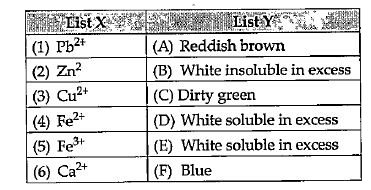You are provided with solutions of sodium hydroxide and ammonium hydroxide. How would you identify each cation in the following pairs of cations which are provided in separate test tubes as solutions?
Zn2+ and Fe3+
To identify the cations Zn2+ and Fe3+ in the provided solutions using sodium hydroxide (NaOH), follow these steps:
Step 1: Prepare the Test Tubes
- Take two separate test tubes containing the unknown solutions of cations Zn2+ and Fe3+.
Step 2: Add Sodium Hydroxide to the First Test Tube
- Add a few drops of sodium hydroxide (NaOH) solution to the first test tube containing one of the cations (let's assume it is Zn2+ for this step).
Step 3: Observe the Reaction
- Observe the reaction. The Zn2+ ion will react with sodium hydroxide to form zinc hydroxide:
Zn2++2NaOH→Zn(OH)2↓
- The product, zinc hydroxide, will appear as a white precipitate.
Step 4: Confirm the Presence of Zn2+
- If a white precipitate forms, it confirms the presence of Zn2+ in the solution.
Step 5: Add Sodium Hydroxide to the Second Test Tube
- Now, take the second test tube (which contains Fe3+) and add a few drops of sodium hydroxide (NaOH) solution.
Step 6: Observe the Reaction
- Observe the reaction. The Fe3+ ion will react with sodium hydroxide to form ferric hydroxide:
Fe3++3NaOH→Fe(OH)3↓
- The product, ferric hydroxide, will appear as a reddish-brown precipitate.
Step 7: Confirm the Presence of Fe3+
- If a reddish-brown precipitate forms, it confirms the presence of Fe3+ in the solution.
Summary
- White precipitate indicates the presence of Zn2+.
- Reddish-brown precipitate indicates the presence of Fe3+.
- Take two separate test tubes containing the unknown solutions of cations Zn2+ and Fe3+.
- Add a few drops of sodium hydroxide (NaOH) solution to the first test tube containing one of the cations (let's assume it is Zn2+ for this step).
- Observe the reaction. The Zn2+ ion will react with sodium hydroxide to form zinc hydroxide:
Zn2++2NaOH→Zn(OH)2↓
- The product, zinc hydroxide, will appear as a white precipitate.
- If a white precipitate forms, it confirms the presence of Zn2+ in the solution.
- Now, take the second test tube (which contains Fe3+) and add a few drops of sodium hydroxide (NaOH) solution.
- Observe the reaction. The Fe3+ ion will react with sodium hydroxide to form ferric hydroxide:
Fe3++3NaOH→Fe(OH)3↓
- The product, ferric hydroxide, will appear as a reddish-brown precipitate.
- If a reddish-brown precipitate forms, it confirms the presence of Fe3+ in the solution.
- White precipitate indicates the presence of Zn2+.
- Reddish-brown precipitate indicates the presence of Fe3+.
Topper's Solved these Questions
- ANALYTICAL CHEMISTRYBOOK - ICSECHAPTER - ANALYTICAL CHEMISTRYEXERCISE - QUESTIONS FOR PRACTICE ON EXAMINATION PATTERN
20 Videos
- ANALYTICAL CHEMISTRYBOOK - ICSECHAPTER - ANALYTICAL CHEMISTRYEXERCISE - Fill in the Blanks
17 Videos
- ANALYTICAL CHEMISTRYBOOK - ICSECHAPTER - ANALYTICAL CHEMISTRYEXERCISE - Figure Based Questions
2 Videos
- ACIDS, BASES AND SALTSBOOK - ICSECHAPTER - ACIDS, BASES AND SALTSEXERCISE - Unit Test Paper 3A- Acids, Bases & Salts
14 Videos
- ANALYTICAL CHEMISTRY- USE OF AMMONIUM HYDROXIDE AND SODIUM HYDROXIDEBOOK - ICSECHAPTER - ANALYTICAL CHEMISTRY- USE OF AMMONIUM HYDROXIDE AND SODIUM HYDROXIDEEXERCISE - Questions from Previous ICSE Board Papers
45 Videos
Similar Questions
Select correct answers from the choices A, B, C, D which are given. Write down only the letter corresponding to the correct answer.
The oxide which reacts with both acid and base is called
View SolutionSalts of normal elements [1 (IA) to 17 (VIIA)] are generally...............
View SolutionSodium hydroxide solution is added to the solutions containing the ions mentioned in list X. Y gives the details of the precipitate. Match the ions with their coloured precipitates.

View SolutionName the following :
A basic solution which does not contain a metallic element.
View SolutionGive one test each to distinguish between the following pairs of chemicals :
Zinc nitrate solution and calcium nitrate solution.
View SolutionThe only cations present in the slightly acidic solution are Fe3+,Zn2+andCu2+. The reagent that when added in exess to this solution would identify and separate Fe3+ in one step is:
View SolutionYou are provided with three test tubes containing distilled water, an acid and a base solution respectively. If you are given only blue litmus paper, how do you identify the contents of each test tube ?
View SolutionSilver chloride is dissolved in excess ammonium hydroxide solution. The cation produced by that solution is
View SolutionYou are provided the solutions of sodium hydroxide (A), hydrochloric acid (B), sodium chloride ( C) and phenolphthalein (P) separately. All the solutions are colourless. How will you identify the solutions of acid, base and salt?
View SolutionIdentify the cation in each of the following case
Sodium hydroxide solution when added to the solution 'A' gives reddish brown precipitate.
View SolutionIdentify the cation in each of the following case Ammonium hydroxide solution when added to the solution B gives white precipitate which dissolves in excess
View SolutionIdentify the cation in each of the following case
Sodium hydroxide solution when added to solution C gives bluish white precipitate which is insoluble in excess.
View SolutionIdentify the substance underlined, in the following case : Cation that does not form a precipitate with ammonium hydroxide but forms one with sodium hydroxide.
View SolutionAnswer the following question : How will you distinguish between Ammonium hydroxide and Sodium hydroxide using copper sulphate solution?
View SolutionHow would you distinguish between Zn2+)andPb2+ using ammonium hydroxide solution.
View Solution
